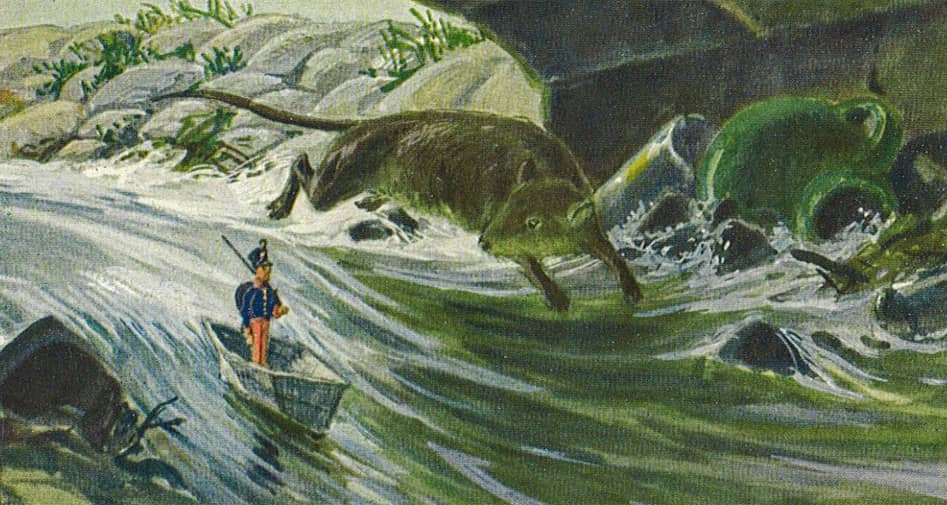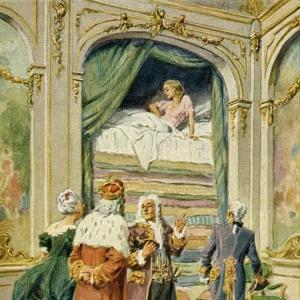Reading time: 13 min
There were once five-and-twenty tin soldiers, who were all brothers, for they had been made out of the same old tin spoon. They shouldered arms and looked straight before them, and wore a splendid uniform, red and blue. The first thing in the world they ever heard were the words, “Tin soldiers!” uttered by a little boy, who clapped his hands with delight when the lid of the box, in which they lay, was taken off. They were given him for a birthday present, and he stood at the table to set them up. The soldiers were all exactly alike, excepting one, who had only one leg; he had been left to the last, and then there was not enough of the melted tin to finish him, so they made him to stand firmly on one leg, and this caused him to be very remarkable.
The table on which the tin soldiers stood, was covered with other playthings, but the most attractive to the eye was a pretty little paper castle. Through the small windows the rooms could be seen. In front of the castle a number of little trees surrounded a piece of looking-glass, which was intended to represent a transparent lake. Swans, made of wax, swam on the lake, and were reflected in it. All this was very pretty, but the prettiest of all was a tiny little lady, who stood at the open door of the castle; she, also, was made of paper, and she wore a dress of clear muslin, with a narrow blue ribbon over her shoulders just like a scarf.
In front of these was fixed a glittering tinsel rose, as large as her whole face. The little lady was a dancer, and she stretched out both her arms, and raised one of her legs so high, that the tin soldier could not see it at all, and he thought that she, like himself, had only one leg. “That is the wife for me,” he thought; “but she is too grand, and lives in a castle, while I have only a box to live in, five-and-twenty of us altogether, that is no place for her. Still I must try and make her acquaintance.”
Then he laid himself at full length on the table behind a snuff-box that stood upon it, so that he could peep at the little delicate lady, who continued to stand on one leg without losing her balance. When evening came, the other tin soldiers were all placed in the box, and the people of the house went to bed. Then the playthings began to have their own games together, to pay visits, to have sham fights, and to give balls. The tin soldiers rattled in their box; they wanted to get out and join the amusements, but they could not open the lid.
The nut-crackers played at leap-frog, and the pencil jumped about the table. There was such a noise that the canary woke up and began to talk, and in poetry too. Only the tin soldier and the dancer remained in their places. She stood on tiptoe, with her legs stretched out, as firmly as he did on his one leg. He never took his eyes from her for even a moment. The clock struck twelve, and, with a bounce, up sprang the lid of the snuff-box; but, instead of snuff, there jumped up a little black goblin; for the snuff-box was a toy puzzle. “Tin soldier,” said the goblin, “don’t wish for what does not belong to you.” But the tin soldier pretended not to hear. “Very well; wait till to-morrow, then,” said the goblin.
When the children came in the next morning, they placed the tin soldier in the window. Now, whether it was the goblin who did it, or the draught, is not known, but the window flew open, and out fell the tin soldier, heels over head, from the third story, into the street beneath. It was a terrible fall; for he came head downwards, his helmet and his bayonet stuck in between the flagstones, and his one leg up in the air. The servant maid and the little boy went down stairs directly to look for him; but he was nowhere to be seen, although once they nearly trod upon him. If he had called out, “Here I am,” it would have been all right, but he was too proud to cry out for help while he wore a uniform.
Presently it began to rain, and the drops fell faster and faster, till there was a heavy shower. When it was over, two boys happened to pass by, and one of them said, “Look, there is a tin soldier. He ought to have a boat to sail in.” So they made a boat out of a newspaper, and placed the tin soldier in it, and sent him sailing down the gutter, while the two boys ran by the side of it, and clapped their hands. Good gracious, what large waves arose in that gutter! and how fast the stream rolled on! for the rain had been very heavy.
The paper boat rocked up and down, and turned itself round sometimes so quickly that the tin soldier trembled; yet he remained firm; his countenance did not change; he looked straight before him, and shouldered his musket. Suddenly the boat shot under a bridge which formed a part of a drain, and then it was as dark as the tin soldier’s box. “Where am I going now?” thought he. “This is the black goblin’s fault, I am sure. Ah, well, if the little lady were only here with me in the boat, I should not care for any darkness.” Suddenly there appeared a great water-rat, who lived in the drain.
“Have you a passport?“ asked the rat, “give it to me at once.” But the tin soldier remained silent and held his musket tighter than ever. The boat sailed on and the rat followed it. How he did gnash his teeth and cry out to the bits of wood and straw, “Stop him, stop him; he has not paid toll, and has not shown his pass.“ But the stream rushed on stronger and stronger. The tin soldier could already see daylight shining where the arch ended. Then he heard a roaring sound quite terrible enough to frighten the bravest man. At the end of the tunnel the drain fell into a large canal over a steep place, which made it as dangerous for him as a waterfall would be to us.
He was too close to it to stop, so the boat rushed on, and the poor tin soldier could only hold himself as stiffly as possible, without moving an eyelid, to show that he was not afraid. The boat whirled round three or four times, and then filled with water to the very edge; nothing could save it from sinking. He now stood up to his neck in water, while deeper and deeper sank the boat, and the paper became soft and loose with the wet, till at last the water closed over the soldier’s head. He thought of the elegant little dancer whom he should never see again, and the words of the song sounded in his ears
“Farewell, warrior! ever brave,
Drifting onward to thy grave.”
Then the paper boat fell to pieces, and the soldier sank into the water and immediately afterwards was swallowed up by a great fish. Oh how dark it was inside the fish! A great deal darker than in the tunnel, and narrower too, but the tin soldier continued firm, and lay at full length shouldering his musket. The fish swam to and fro, making the most wonderful movements, but at last he became quite still. After a while, a flash of lightning seemed to pass through him, and then the daylight approached, and a voice cried out, “I declare here is the tin soldier.” The fish had been caught, taken to the market and sold to the cook, who took him into the kitchen and cut him open with a large knife.
She picked up the soldier and held him by the waist between her finger and thumb, and carried him into the room. They were all anxious to see this wonderful soldier who had travelled about inside a fish; but he was not at all proud. They placed him on the table, and — how many curious things do happen in the world! there he was in the very same room from the window of which he had fallen, there were the same children, the same playthings, standing on the table, and the pretty castle with the elegant little dancer at the door; she still balanced herself on one leg, and held up the other, so she was as firm as himself. It touched the tin soldier so much to see her that he almost wept tin tears, but he kept them back. He only looked at her and they both remained silent.
Presently one of the little boys took up the tin soldier, and threw him into the stove. He had no reason for doing so, therefore it must have been the fault of the black goblin who lived in the snuff-box. The flames lighted up the tin soldier, as he stood, the heat was very terrible, but whether it proceeded from the real fire or from the fire of love he could not tell. Then he could see that the bright colors were faded from his uniform, but whether they had been washed off during his journey or from the effects of his sorrow, no one could say. He looked at the little lady, and she looked at him. He felt himself melting away, but he still remained firm with his gun on his shoulder.
Suddenly the door of the room flew open and the draught of air caught up the little dancer, she fluttered like a sylph right into the stove by the side of the tin soldier, and was instantly in flames and was gone. The tin soldier melted down into a lump, and the next morning, when the maid servant took the ashes out of the stove, she found him in the shape of a little tin heart. But of the little dancer nothing remained but the tinsel rose, which was burnt black as a cinder.
 Learn languages. Double-tap on a word.Learn languages in context with Childstories.org and Deepl.com.
Learn languages. Double-tap on a word.Learn languages in context with Childstories.org and Deepl.com.Backgrounds
Interpretations
Linguistics
„The Brave Tin Soldier“ is a classic fairy tale by Hans Christian Andersen that weaves a tale of bravery, love, and fate. The story revolves around a set of tin soldiers, all identical except for one who has only one leg due to a shortage of tin. This one-legged soldier becomes the central character of the narrative.
The tale begins with a little boy who receives these tin soldiers as a birthday gift. Among the playthings is a beautiful paper castle inhabited by a delicate paper dancer, who fascinates the one-legged tin soldier. She appears to be standing on one leg, much like him, which makes him admire her even more, seeing her as a suitable partner despite the social distance between their different worlds.
As night falls, the toys come to life, but the tin soldier remains at his post, gazing at the dancer. A black goblin inside a toy snuff-box warns him not to wish for things that do not belong to him, foreshadowing the trials ahead. The next day, a mysterious force causes the tin soldier to fall out the window, setting off a series of adventures.
The tin soldier’s journey takes him through the rain, down a gutter in a makeshift paper boat, into the dark depths of a drain, and eventually into the belly of a fish. Throughout these ordeals, he maintains his stoic courage and determination, embodying the themes of steadfastness and resolve.
In an unexpected twist of fate, the fish that swallowed him is caught, and the tin soldier is returned to the very room he fell from. He is once again confronted with the paper dancer, and for a moment, it seems like a happy ending might be within reach. However, a tragic culmination ensues when a boy throws the tin soldier into the stove, leading to his and the dancer’s simultaneous demise, united in the fire.
The story concludes with the maid finding a tin heart among the ashes, symbolizing the soldier’s enduring love and bravery, while the dancer’s rose, charred but still intact, serves as a poignant reminder of her presence.
„The Brave Tin Soldier“ explores themes of love, persistence in the face of adversity, and the acceptance of one’s fate, leaving readers with a melancholic yet insightful reflection on the nature of heroism and sacrifice.
„The Brave Tin Soldier“ by Hans Christian Andersen is a classic fairy tale that can be interpreted in many ways. Here are a few different interpretations that can be drawn from the story:
Romantic Idealism vs. Reality:
The one-legged tin soldier’s instant affection for the dancer is an example of romantic idealism. He believes she is like him because they both appear to have one leg, and he dreams of being with her despite their different social standings (the castle vs. the box). His journey could symbolize the challenges faced when pursuing love that seems out of reach.
Perseverance and Stoicism:
The tin soldier’s stoic nature throughout his perilous journey showcases perseverance and bravery. Despite the obstacles he faces—from the fall to the drainage to being swallowed by a fish—he remains steadfast and composed. This can be interpreted as a metaphor for facing life’s challenges with dignity and resilience.
Fate and Destiny:
The story can be seen as a meditation on fate. The tin soldier seems to be at the mercy of external forces (the goblin’s warning, the wind, the actions of the boy), and yet he ultimately returns to the place he started, suggesting a cyclical nature of destiny. His fate ends with a kind of poetic justice when he becomes a molten heart.
Loss and Sacrifice:
The ending of the story, with both the soldier and the dancer consumed by the fire, can symbolize the concept of ultimate sacrifice in the name of love. Their melting together—though tragic—renders them inseparable in the end, suggesting that true love may come with sacrifice.
Critique of Social Norms:
The tin soldier’s journey can also be interpreted as a critique on rigid societal roles and norms. The soldier, despite his bravery and desire, finds himself repeatedly cast aside and out of place in a world that doesn’t accommodate his differences or aspirations beyond his status as a toy soldier.
The Power of Imagination:
The story takes simple objects—tin soldiers, paper boats, paper dancers—and infuses them with life and emotion. This highlights the power of imagination and storytelling, where inanimate objects are filled with personality and embark on dramatic adventures, reflecting how stories can bring vitality and depth to the mundane.
These interpretations reveal different layers of meaning within Andersen’s fairy tale, making it rich in symbolism and open to personal reflection.
Linguistic analysis of Hans Christian Andersen’s „The Brave Tin Soldier“ involves examining various aspects of language, style, and literary devices used in the fairy tale.
Third-Person Omniscient Narration: The story is told from a third-person perspective, providing the narrator with the ability to describe the thoughts and feelings of the tin soldier and other characters. This style allows the reader to understand the internal motivations of the tin soldier and adds depth to the narrative.
Dialogue: Although not heavily reliant on dialogue, the story uses it sparingly to add dramatic effect, such as the goblin’s warning to the tin soldier.
Characterization
Personification: The tin soldiers and other toys are given human-like qualities, such as the ability to think, feel, and endure challenges. This personification makes the story relatable and engaging for readers, particularly its intended audience of children.
Symbolism: The tin soldier represents steadfastness and courage, while the dancer symbolizes beauty and grace. The interaction between these symbolic characters provides a contrast between the steadfast, unyielding soldier and the ethereal, delicate dancer.
Themes
Courage and Perseverance: The tin soldier’s journey, which involves overcoming numerous obstacles, symbolizes the virtues of bravery and steadfastness in the face of adversity.
Fate and Destiny: The tin soldier’s journey is driven by forces beyond his control, suggesting themes of destiny and the inevitability of certain outcomes.
Love and Sacrifice: The soldier’s admiration for the dancer and their eventual mutual destruction in the fire convey themes of love, sacrifice, and the ephemeral nature of both.
Imagery and Descriptive Language: Andersen uses vivid imagery to create a rich and detailed world, from the sumptuous description of the paper castle to the roaring waters of the gutter. This imagery helps convey the magical and perilous elements of the soldier’s adventure. Contrasting elements such as light and darkness are frequently used to highlight the tin soldier’s isolation and his journey from the bright, playful world of toys to the dark interior of the fish and the stove.
Moral and Philosophical Undertones
Morality: The tale explores notions of right and wrong, often positioning the tin soldier as a figure of moral integrity against the mischievous goblin and other forces that threaten his resolve.
Existential Reflections: The story’s conclusion, where the soldier and the dancer are consumed by fire, offers an existential reflection on life, love, and what ultimately takes lasting form (the tin heart).
Structure and Pacing
Linear Progression: The story follows a clear, linear progression that traces the tin soldier’s journey through various predicaments. This structure makes it accessible and easy to follow for young readers.
Rhythmic Text: Andersen’s writing has a rhythmic quality, with repetitive phrasing used to emphasize key themes, such as the soldier’s steadfast nature.
Overall, „The Brave Tin Soldier“ is a rich, multi-layered story that combines narrative, character, and thematic elements with linguistic complexity to create a timeless fairy tale.
Information for scientific analysis
Fairy tale statistics | Value |
|---|---|
| Translations | DE, EN, DA, ES, FR, IT, NL, RO |
| Readability Index by Björnsson | 32 |
| Flesch-Reading-Ease Index | 77.4 |
| Flesch–Kincaid Grade-Level | 7.7 |
| Gunning Fog Index | 10.5 |
| Coleman–Liau Index | 7.8 |
| SMOG Index | 9.2 |
| Automated Readability Index | 7.9 |
| Character Count | 9.076 |
| Letter Count | 6.990 |
| Sentence Count | 83 |
| Word Count | 1.747 |
| Average Words per Sentence | 21,05 |
| Words with more than 6 letters | 191 |
| Percentage of long words | 10.9% |
| Number of Syllables | 2.231 |
| Average Syllables per Word | 1,28 |
| Words with three Syllables | 90 |
| Percentage Words with three Syllables | 5.2% |

 Facebook
Facebook  Whatsapp
Whatsapp  Messenger
Messenger  Telegram
Telegram Reddit
Reddit














